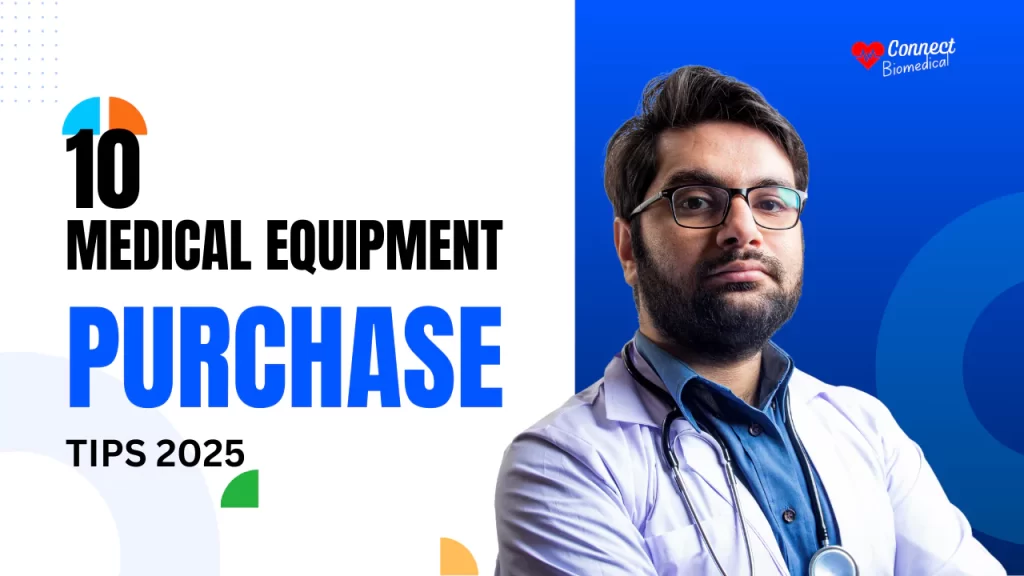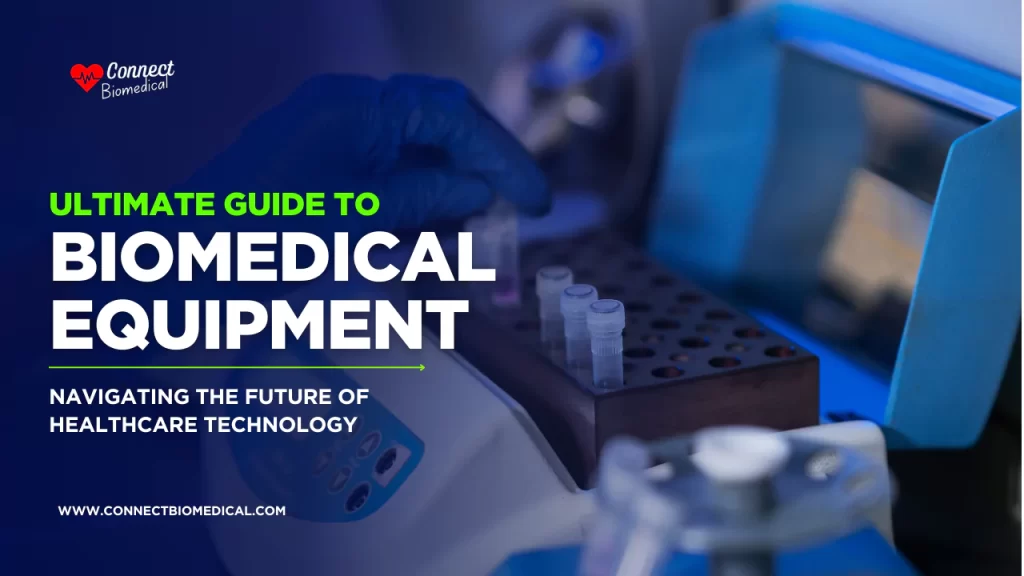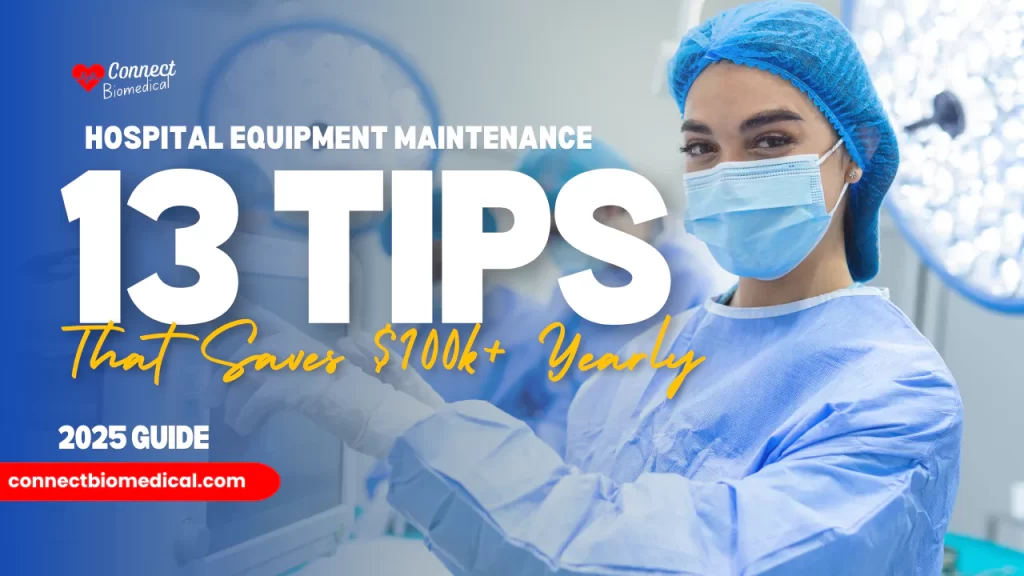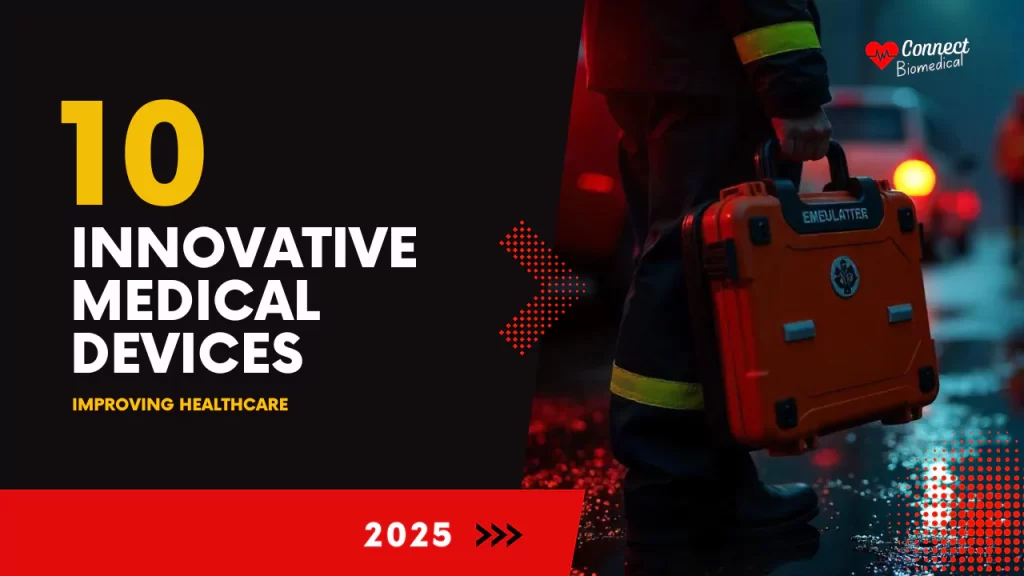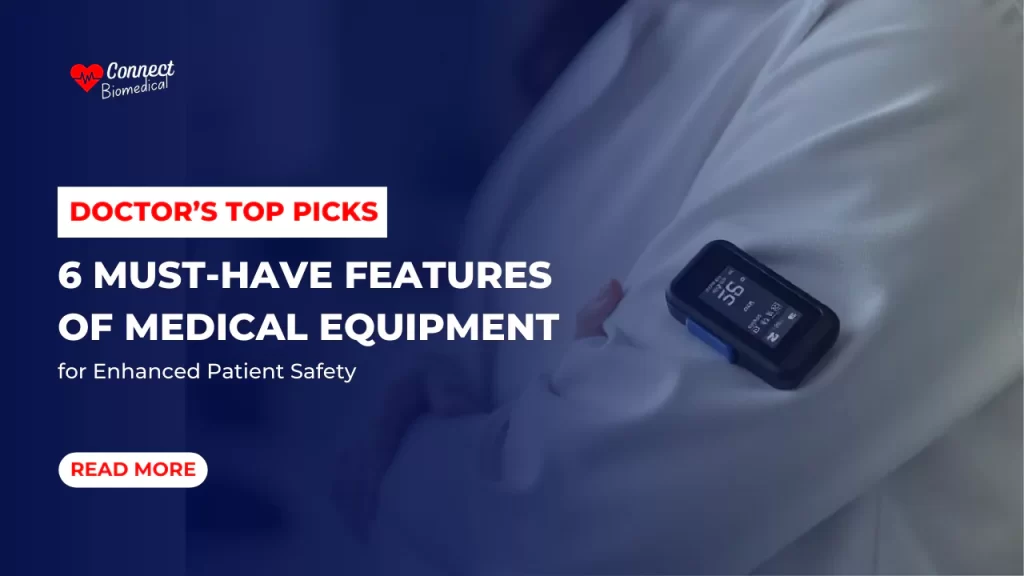Purchasing medical equipment for the first time can feel like navigating a maze blindfolded.
Between technical jargon, budget constraints, and the pressure to prioritize patient safety, it’s easy to feel overwhelmed. But here’s the thing: the decisions you make today will impact your facility’s efficiency, reputation, and bottom line for years to come.
Whether you’re outfitting a startup clinic, expanding services, or upgrading outdated tools, cutting corners or rushing the process isn’t an option.
The stakes are high—subpar equipment can compromise care quality while overspending on unnecessary features strains budgets. That’s why first-time buyers need a roadmap to balance cost, compliance, and long-term value.
In this guide, we’ll unpack 10 non-negotiable priorities seasoned professionals swear by, from avoiding hidden costs to future-proofing your investments. Think of this as your cheat sheet for making confident, informed choices—no guesswork required.
Let’s dive in.
10 Important Things to Know When Purchasing Medical Equipment
- Assess Your Needs and Facility Requirements
- Prioritize Quality and Long-Term Value
- Choose Simple and Reliable Equipment
- Check Certifications and Regulatory Compliance
- Opt for Versatile and Scalable Equipment
- Decide Between New vs. Refurbished Equipment
- Evaluate Total Cost of Ownership
- Research Supplier Reputation and Support Services
- Explore Financing and Budgeting Options
- Avoid Common Mistakes First-Time Buyers Make
1. Assess Your Needs and Facility Requirements
Before you fall in love with the latest high-tech gadget or a “too-good-to-miss” deal, pause and ask: What does your facility truly need? Buying medical equipment isn’t one-size-fits-all—it’s about aligning your purchase with your unique operational realities.
Here’s how to start:
Identify Your Specific Medical Requirements
Your facility type dictates your priorities. A bustling urban hospital will have different needs than a small rural clinic or a home care setup. For example:
- Clinics: Focus on versatile, mid-range devices for diagnostics.
- Hospitals: Prioritize heavy-duty, high-volume equipment.
- Home Care: Opt for lightweight, user-friendly devices.
Pro Tip: Create a “needs vs. wants” list. Does your home care patient need a portable ECG monitor, or is a basic blood pressure cuff sufficient?
Separate Essential Equipment from “Nice-to-Haves”
It’s easy to get swayed by cutting-edge features you’ll rarely use. Start by categorizing:
- Essential: Equipment required for daily operations or life-saving interventions (e.g., defibrillators, sterilizers).
- Optional: Upgrades that enhance efficiency but aren’t urgent (e.g., a robotic surgery arm for a general practice).
A pediatric clinic splurged on a high-end fetal monitor but overlooked basic pediatric pulse oximeters—forcing them to reprioritize their budget mid-project.
Check Compatibility with Existing Systems
That sleek new device won’t add value if it can’t “talk” to your current setup. Ask:
- Software Integration: Will the new imaging system sync with your EHR platform?
- Physical Space: Is there enough room (and power supply) for a full-sized CT scanner?
- Workflow Fit: Will nurses waste time manually transferring data from the device to patient records?
A hospital once bought endoscopes that weren’t compatible with their sterilization units, causing costly delays. Always request compatibility specs upfront!
Start by looking hard at your facility’s actual needs—not the ones the glossy brochure promises.
Involve your team, audit your workflows, and remember that, the right equipment solves problems, not creates new ones.
2. Prioritize Quality and Long-Term Value
Let’s get real: When it comes to medical equipment, “cheap” is rarely a bargain. High-quality devices aren’t just about shiny specs—they’re about trust. A malfunctioning monitor during surgery or a glitchy imaging system could jeopardize patient safety and your facility’s credibility. Here’s why cutting corners costs more in the long run—and how to invest wisely.
Why Quality Directly Impacts Patient Outcomes
Reliable equipment is the backbone of effective care. For example:
- Accuracy matters: A poorly calibrated blood analyzer could misdiagnose conditions, delaying critical treatment.
- Consistency saves lives: Imagine a defibrillator failing during a cardiac emergency because of subpar internal components.
- Reduced errors: Well-designed devices minimize user mistakes.
Pro Tip: Look for ISO certifications or FDA approvals—they’re proof of rigorous safety and performance testing.
The Hidden Costs of “Budget” Equipment
That $5,000 ECG machine might save you money today, but what happens when…
- Frequent breakdowns disrupt workflows and force costly emergency repairs.
- Short lifespans mean replacing devices every 2-3 years instead of 10+.
- Poor performance leads to retests, wasted resources, and patient dissatisfaction.
A rehab center bought discounted therapeutic ultrasound units. Within a year, 40% failed—costing them more in replacements than buying premium models upfront.
“Prioritize quality and long-term value over upfront cost. Invest in durable, reputable equipment—it ensures better patient outcomes, fewer breakdowns, and lower costs. Align purchases with your clinic’s workflow and avoid cheap alternatives that often fail within a year. Always verify warranties, training, and service support. For instance, with 30 years in physiotherapy, I opted for premium Pilates reformers over flimsy models. This decision improved patient recovery and saved us from costly replacements.”
— Peter Hunt, Director & Physiotherapist, The Alignment Studio
Quality isn’t a luxury—it’s Necessary.
3. Choose Simple and Reliable Equipment
In healthcare, complexity isn’t a badge of honor—it’s a liability. Whether you’re outfitting a hospital or equipping a home caregiver, user-friendly design isn’t optional. Complicated devices waste time, frustrate users, and increase the risk of errors.
Here’s how to prioritize simplicity without sacrificing quality.
Why User-Friendly Design Matters
- Reduces Errors: Confusing interfaces lead to mistakes. Think: A caregiver misprogramming a medication dispenser because of cluttered buttons.
- Saves Time: Intuitive controls mean less training and faster adoption.
- Boosts Compliance: Patients are more likely to use equipment they understand (e.g., a blood glucose monitor with a one-button operation).
Pro Tip: Test equipment with actual users before buying. If a nurse or patient struggles during the demo, it’s not the right fit.
The Hidden Costs of Complexity
High-tech gadgets might look impressive, but they often create more problems than they solve. For example:
- Training Overload: Staff spend hours mastering features they’ll rarely use.
- Maintenance Hassles: Proprietary software or rare parts can delay repairs.
- Abandonment Risk: Patients may ignore devices that feel overwhelming.
A home health agency bought “smart” IV pumps with 10+ settings. Within months, 30% were returned due to user errors.
When choosing medical gear for home use, prioritize ease of use for patients and caregivers. Complex devices cause stress and dangerous slip-ups. Start by pinpointing exact needs—mobility aids, monitors, or daily living tools—and stick to brands known for reliability. Look for clear controls, durable builds, and safety certifications. Never skip post-purchase support: warranties, maintenance access, and responsive customer service aren’t extras—they’re lifelines.
Christian’s Checklist for Home Equipment:
- Safety First: Ensure devices meet FDA/CE standards.
- Durability Tests: Opt for scratch-resistant, waterproof materials.
- Support Guaranteed: Confirm repair timelines and spare part availability.
Simplicity isn’t about cutting corners—it’s about cutting risks. Choose equipment that’s easy to operate, easy to maintain, and hard to break.
“Your goal isn’t to impress with tech specs. It’s to empower patients and caregivers with tools they’ll actually use.”
4. Check Certifications and Regulatory Compliance
Buying medical equipment without verifying certifications is like driving without a seatbelt—it might seem fine until disaster strikes. Regulatory compliance isn’t just red tape; it’s your first line of defense against unsafe products, legal headaches, and reputational ruin.
Here’s how to ensure every purchase meets the mark.
Why Industry Standards Matter
FDA, CE, or ISO certifications aren’t just acronyms—they’re proof that a device has passed rigorous safety and performance tests. For example:
- FDA (U.S.): Ensures devices are safe for medical use.
- CE (Europe): Confirms compliance with EU health and environmental standards.
- ISO 13485: A global benchmark for quality management in medical device manufacturing.
Pro Tip: Always ask suppliers for certification documents. If they can’t provide them, consider it a dealbreaker.
Patient Safety & Legal Survival Go Hand-in-Hand
Non-compliant equipment risks:
- Patient harm: Malfunctioning defibrillators or unsterile surgical instruments.
- Fines or shutdowns: Regulatory bodies will penalize facilities using uncertified gear.
- Lawsuits: A single injury linked to substandard equipment can lead to costly litigation.
A clinic once bought “discounted” ultrasound machines without FDA clearance. They were fined $50K and forced to halt services until replacements arrived.
Vet Suppliers Like Your Reputation Depends on It (Because It Does)
Counterfeit or knockoff products flood the market, often disguised as “budget-friendly” alternatives. Protect yourself by:
- Checking credentials: How long has the supplier been in business? Do they work with reputable hospitals?
- Reading reviews: Search for complaints about counterfeit gear or delayed certifications.
- Requesting third-party audits: Reputable suppliers will share compliance reports.
Alert: Be wary of prices that seem too good to be true. A $200 ECG machine claiming FDA approval is likely a scam.
5. Opt for Versatile and Scalable Equipment
In a field as dynamic as healthcare, today’s cutting-edge tech can become tomorrow’s paperweight. The key to avoiding costly obsolescence? Invest in equipment that grows with your needs, not against them.
Versatile and scalable tools aren’t just smart—they’re essential for staying agile in a rapidly evolving industry.
Why Multi-Functional Equipment Delivers Better ROI
A single device that handles multiple tasks saves money, space, and headaches. For example:
- Cost efficiency: A portable ultrasound that doubles as a vascular Doppler eliminates buying two devices.
- Space optimization: Compact, multi-use machines free up room for patient care.
- Simplified training: Staff master one system instead of juggling several.
A rural clinic replaced three aging devices with one modular diagnostics tool, cutting maintenance costs by 60% and reducing errors caused by inconsistent data.
Future-Proofing with Scalable Technology
Healthcare advancements won’t wait—your equipment shouldn’t either. Scalability ensures you’re ready for:
- New treatments: Upgradable software for AI-driven diagnostics.
- Higher patient volume: Machines that handle increased workloads without replacements.
- Regulatory changes: Modular designs that adapt to updated safety standards.
Pro Tip: Ask suppliers about backward compatibility. Can today’s MRI machine integrate with tomorrow’s AI analytics platform?
Always prioritize versatility and multi-functionality. A device that integrates with your EHR today and accepts software updates tomorrow extends its lifespan exponentially. Scalability isn’t a luxury—it’s a necessity. For instance, our clients now demand 5G-ready monitors to support telehealth expansions. If your equipment can’t evolve, you’ll waste resources playing catch-up.
Ivan Rodimushkin, Founder, CEO, XS Supply
6. Decide Between New vs. Refurbished Equipment
Choosing between new and refurbished medical equipment isn’t about “cheap vs. expensive”—it’s about balancing your budget, needs, and risk tolerance. Both options have their place, but knowing when to pick one over the other can save you thousands without cutting corners.
Let’s break it down.
New Equipment: Pros & Cons
Pros
- Latest Technology: Access to cutting-edge features and updates (e.g., AI-powered diagnostics, energy-efficient designs).
- Full Warranty: Typically includes 1–3 years of comprehensive coverage for parts and labor.
- Zero Wear & Tear: No hidden surprises—you’re the first user.
Cons
- Higher Cost: Premium prices for brand-new models (e.g., a new MRI machine can cost $1M+).
- Faster Obsolescence: Rapid tech advances may shorten its relevance.
Certified Refurbished Equipment: Pros & Cons
Pros
- Cost Savings: Up to 50% cheaper than new (e.g., a refurbished ultrasound for 15Kvs.30K new).
- Rigorous Testing: Reputable vendors restore devices to meet original manufacturer specs.
- Eco-Friendly: Reduces e-waste and supports sustainability goals.
Cons
- Shorter Lifespan: May need replacement sooner than new equipment.
- Limited Availability: Popular models sell out quickly.
When Refurbished Makes Sense
- Budget Constraints: Ideal for startups or facilities expanding on a tight budget.
- Non-Critical Devices: For backup equipment (e.g., infusion pumps) or low-risk tools (e.g., exam tables).
- Proven Technology: Older models are still widely used and supported (e.g., certain ECG machines).
A dental clinic saved 40% by buying refurbished autoclaves, using the savings to upgrade their digital X-ray system.
Cost-Saving Strategies Without Sacrificing Quality
- Buy From Certified Vendors: Look for ISO 13485-certified refurbishers or OEM-approved partners.
- Demand Warranty Coverage: Aim for at least 1 year—reputable sellers offer this.
- Review Service History: Ensure the device was inspected, repaired, and tested post-refurbishment.
- Calculate Total Cost of Ownership (TCO): Include maintenance, downtime, and lifespan.
7. Evaluate Total Cost of Ownership
Think of medical equipment costs like an iceberg—the purchase price is just the tip. Hidden beneath are expenses that can sink your budget if ignored.
Evaluating Total Cost of Ownership (TCO) means looking beyond the sticker price to anticipate every dollar your facility will spend over the device’s lifespan.
Here’s how to avoid financial surprises.
Why the Purchase Price Is Just the Start
That $50,000 MRI machine might seem like the biggest expense, but consider:
- Installation: Electrical upgrades, structural modifications, or specialized plumbing.
- Training: Hours lost to staff onboarding or hiring external trainers.
- Maintenance: Annual service contracts (5–10% of the purchase price).
- Repairs: Emergency fixes, parts replacement, and downtime costs (up to $1,000/hour for halted procedures).
A hospital bought a 200K surgical laser but didn’t budget for 25K/year in maintenance. Within two years, TCO surpassed the initial price.
Hidden Costs to Budget For
Installation Logistics:
- Will the device fit through doorways or require renovations?
- Are specialized technicians needed for setup?
Training:
- Does the supplier offer free training, or will you pay $150/hour for third-party help?
Ongoing Maintenance:
- Are proprietary parts required (e.g., $500 for a single sensor)?
Downtime Risks:
- How quickly can the supplier fix a broken device? A day? A week?
Pro Tip: Calculate TCO using this formula: Purchase Price + (Annual Maintenance x Years Used) + Training + Downtime Losses
Don’t just look at the price tag. The biggest mistake is choosing the cheapest option without considering maintenance, durability, or after-sales support. A higher upfront cost can save headaches later. I’ve seen clinics buy dental chairs or imaging gear only to struggle with scarce parts or weeks-long repairs. That downtime costs money and trust. Always check warranties, service agreements, and part availability.
For example, a partner clinic in Turkey saved thousands by opting for high-quality refurbished models with manufacturer-backed warranties. The lesson? Research thoroughly, talk to peers using the equipment, and ensure reliable local support. A ‘great deal’ isn’t great if it leaves you stranded when things break.
Odellé Joubert, Chief Operating Officer, Dentaly Go
TCO isn’t about pinching pennies—it’s about protecting your facility from financial icebergs.
As Odellé puts it: “Smart buyers don’t just ask, ‘What’s the price?’ They ask, ‘What’s the real cost?’”
8. Research Supplier Reputation and Support Services
Buying medical equipment isn’t just about the device—it’s about the partner behind it. An unreliable supplier can turn a “great deal” into a nightmare of delays, hidden fees, and broken promises.
Here’s how to separate trustworthy vendors from risky bets and ensure long-term peace of mind.
How to Vet Supplier Credibility
A supplier’s reputation is your first clue to their reliability. Start by asking:
- Are they certified? Look for ISO 13485 (quality management) or OEM-authorized partnerships.
- How long have they been in business? Prioritize suppliers with 5+ years in healthcare.
- Who’s on their client list? Reputable vendors work with hospitals, clinics, or recognized healthcare networks.
Alert: Avoid suppliers who dodge questions about certifications or refuse to share client references.
A rehab center partnered with a fly-by-night vendor offering “discounted” physiotherapy equipment. The devices arrived with outdated software, and the supplier ghosted them post-purchase.
Dig into Reviews, Testimonials, and References
Online specs can lie—reviews rarely do. Here’s how to investigate:
- Check Industry Forums: Sites like MedTech Talk or HealthTech Wire reveal unfiltered user experiences.
- Ask for References: Demand 2–3 contacts from similar-sized facilities. Did the supplier deliver on time? Honor warranties?
- Social Proof: LinkedIn recommendations or case studies add credibility.
Pro Tip: Watch for patterns. If multiple users complain about delayed repairs or poor communication, steer clear.
A hospital avoided a $100K mistake by contacting a reference who revealed the supplier’s MRI machines had recurring calibration issues.
After-Sales Service: The Lifeline You Can’t Ignore
Even the best equipment will eventually need support. Prioritize suppliers who offer:
- 24/7 Technical Assistance: Critical for emergencies (e.g., a failed anesthesia machine during surgery).
- Local Service Networks: Faster repairs mean less downtime.
- Transparent Warranties: Does coverage include labor, parts, and software updates?
Compare These Two Scenarios:
- Supplier A: Offers a 10% discount but takes 2 weeks to fix devices.
- Supplier B: Costs slightly more but guarantees 48-hour repairs.
Which Would You Choose?
Key Questions to Ask Suppliers before making the purchase
- What’s your average repair turnaround time?
- Do you provide loaner equipment during repairs?
- Can you share a recent compliance audit or service report?
A supplier’s reputation and support services are as critical as the equipment itself. As one procurement manager put it: “You’re not just buying a machine—you’re buying a relationship.” Do the homework upfront, and you’ll avoid costly divorces later.
9. Explore Financing and Budgeting Options
Let’s face it: Even the most essential medical equipment can strain your budget. But with the right financial strategy, you can acquire what you need without draining your resources.
Whether you’re buying, leasing, or hunting for grants, here’s how to make your money work smarter—not harder.
Outright Purchase vs. Leasing vs. Financing: What’s Best?
Each option has pros and cons, depending on your facility’s cash flow and long-term goals:
| Option | Pros | Cons | Best For |
| Outright Purchase | Full ownership, no interest fees | High upfront cost; risk of obsolescence | Stable budgets, long-term needs |
| Leasing | Lower upfront cost; easy upgrades | Higher long-term cost; no equity | Short-term needs or tech-heavy tools |
| Financing | Spread payments over time; build equity | Interest adds to the total cost | Mid-sized clinics with steady revenue |
A diagnostic lab leased a $300K digital X-ray system, upgrading every 3 years to stay current with AI advancements—without massive upfront costs.
How to Calculate ROI: Is the Investment Worth It?
ROI isn’t just about dollars—it’s about value. Use this formula to decide if a device pays off:
ROI = [(Net Benefits – Total Cost) / Total Cost] x 100
Net Benefits Include:
- Revenue from procedures (e.g., 150/scan x 1,000 patients/year = 150K).
- Cost savings (e.g., reduced manual labor, lower error rates).
- Indirect gains (e.g., improved patient retention, competitive edge).
Total Cost Includes:
Purchase/lease fees, installation, training, maintenance, and downtime.
Pro Tip: If a 50K ultrasound generates 200 K/year in revenue, your ROI is 300% in Year 1. But if it requires $30K/year in upkeep, recalculate!
Government Grants & Funding Programs
Don’t overlook free money! Many programs subsidize medical equipment for qualifying facilities:
- Federal: Check the USDA’s Rural Development Grants or HRSA’s Ryan White HIV/AIDS Program.
- State/Local: Some states fund community health centers or nonprofit clinics.
- Nonprofits: Organizations like MedShare or Direct Relief donate equipment to underserved areas.
A rural clinic secured a $75K state grant to buy telemedicine carts, expanding access to specialist care.
Key Questions to Guide Your Decision
- Cash Flow: Can you afford a large upfront payment, or do you need smaller installments?
- Tech Lifespan: Will the device become outdated in 2 years? If so, leasing may beat buying.
- Eligibility: Does your facility qualify for grants (e.g., rural, nonprofit, serving low-income populations)?
There’s no one-size-fits-all answer—only the right fit for your facility’s needs.
Crunch the numbers, explore grants, and remember: A well-planned budget today prevents financial headaches tomorrow. As one CFO wisely said, “ROI isn’t just about profit. It’s about sustainability.”
10. Avoid Common Mistakes First-Time Buyers Make
First-time medical equipment buyers often walk into pitfalls that seasoned pros sidestep effortlessly. These mistakes don’t just waste money—they risk patient safety, operational efficiency, and your facility’s reputation. Let’s break down the top blunders and how to dodge them like a pro.
1. Impulse Buying Without Research
- The Trap: Falling for flashy marketing or pressure sales tactics. (“This AI-powered scanner is selling fast—buy now!”)
- The Reality: Hasty purchases lead to buyer’s remorse. Example: A clinic bought a robotic surgery system without realizing it required $200K/year in maintenance.
How to Avoid It:
Create a Needs Assessment Checklist: Involve stakeholders (doctors, IT, finance) to align purchases with actual needs.
- Sleep on It: Wait 48 hours before finalizing big-ticket decisions.
- Compare 3+ Suppliers: Prices and terms vary wildly—shop around.
2. Ignoring Long-Term Costs & Support
- The Trap: Fixating on the upfront price while ignoring hidden expenses.
- The Reality: A 20K “bargain” device can cost 50K+ over five years with repairs, downtime, and training.
A hospital purchased MRI machines without factoring in service contracts. When a coolant leak shut down operations for a week, they lost 120K in revenue—plus 15K in emergency repairs.
How to Avoid It:
- Demand a Total Cost of Ownership (TCO) Estimate from suppliers.
- Ask: “What’s your average repair turnaround time?”
- Test Support Responsiveness: Call their helpline before buying.
3. Overlooking Compliance & Warranties
- The Trap: Assuming all equipment meets regulatory standards—or that warranties are “one-size-fits-all.”
- The Reality: Non-compliant gear can lead to fines, lawsuits, or patient harm. Example: A surgery center used unapproved sterilization trays, resulting in a state-mandated shutdown.
How to Avoid It:
- Verify Certifications: Check FDA/CE markings and cross-reference them on official databases.
- Read Warranty Fine Print: Does it cover software updates? Labor costs?
Suppliers who say, “Trust us, it’s compliant,” without proof.
Mistakes happen when urgency overrides caution. Slow down, ask hard questions, and remember: In healthcare procurement, avoiding errors is just as critical as making smart purchases.
As one industry veteran quipped, “The best deal is the one that doesn’t come back to haunt you.”
Conclusion
Purchasing medical equipment for the first time is a high-stakes balancing act—one that demands equal parts research, foresight, and humility. While the process can feel daunting, arming yourself with the right priorities transforms uncertainty into confidence.
Let’s recap the essentials:
Key Takeaways
- Needs Over Wants: Audit your facility’s actual requirements before spending a dime.
- Quality = Longevity: Prioritize durable, certified equipment—it’s cheaper than replacing subpar tools yearly.
- Compliance Is Non-Negotiable: Skip regulatory checks, and you risk fines, lawsuits, or worse.
- Total Cost > Sticker Price: Factor in installation, training, maintenance, and downtime.
- Support Matters: Vet suppliers for after-sales service, warranties, and repair speed.
Why Informed Decisions Save More Than Money
Every dollar spent on medical equipment should serve two masters: patient care and financial sustainability. Cutting corners to save upfront costs often backfires—think recalls, lawsuits, or reputational damage.
Conversely, investing in well-researched, future-proof tools pays dividends in efficiency, trust, and peace of mind.
As the saying goes, “Buy cheap, buy twice.” In healthcare, that second purchase could come at the cost of a patient’s well-being.
Don’t Go It Alone
Even seasoned buyers lean on expertise. Before finalizing any purchase:
- Consult Biomeds or IT Teams: They’ll flag compatibility issues or hidden tech demands.
- Talk to Peers: Learn from others’ wins and mistakes in forums or LinkedIn groups.
- Engage Industry Experts: Procurement consultants or compliance officers can spot risks you might miss.
Final Thought
Your facility’s success hinges on the tools you choose today. Whether you’re buying a single stethoscope or outfitting an entire OR, let this guide be your compass—but never underestimate the value of a second opinion.

